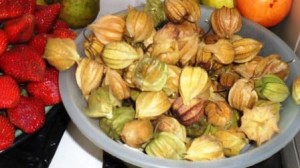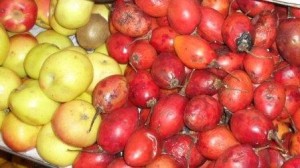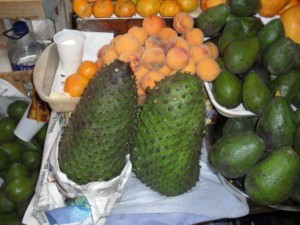A trip to Ecuador always seemed linked to a once in a lifetime Galapagos Islands experience. We are both animal lovers and thought this would be an obvious trip for us to take. Alas, the facts don’t bear out the dream. It turns out that the constant flow of tourists is having a detrimental impact on the very ecosystem that visitors yearn for. Due to this reason, we made a conscious decision to nix the Galapagos visit.
So we lost the Gallapagos, but we gained Ecuador’s Capital and Unesco Heritage Site, Quito.
We arrive in Quito after a way too long trip that took us from Nicaragua up to Miami, 5 hour lay over, then back down (over Nicaragua) to Quito for a 17 hour trip that could have been done in 2 hours if there had been a direct flight, which there isn’t.
First thing we notice as we step out of airport is how cool it is and people are wearing jackets. How silly of us, it is “winter” and we had not anticipated needing anything more than T-shirts. Evening is 50 degrees-ish.
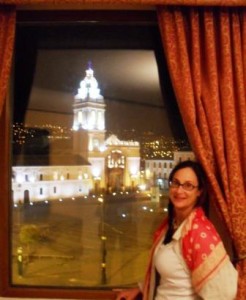 Our next surprise is that when we get to the hotel, it’s closed and no one answers the bell. So what to do? We manage to find another hotel and what a place! The large windows overlook the Plaza Santo Domingo and its grand church.
Our next surprise is that when we get to the hotel, it’s closed and no one answers the bell. So what to do? We manage to find another hotel and what a place! The large windows overlook the Plaza Santo Domingo and its grand church.
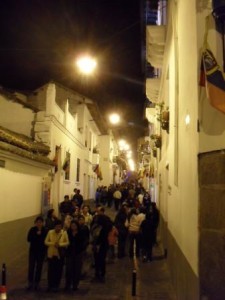 Peta is eager to go discover the city, so to the streets we take. It’s 11 oclock at night and the nearby cobble stone street of the Old Town is teaming with locals enjoying their Friday night. There are many tiny bars/restaurants with live music and lots of people dancing to Andes flute and guitar music.
Peta is eager to go discover the city, so to the streets we take. It’s 11 oclock at night and the nearby cobble stone street of the Old Town is teaming with locals enjoying their Friday night. There are many tiny bars/restaurants with live music and lots of people dancing to Andes flute and guitar music.
First bites on first night include: A fried empanada stuffed with mild cheese and covered with sugar. YUM! Cuy (Guinea Pig). Peta refuses to eat something she considers a pet but I dig in and initially try with knife and fork, much to the amusement of a man at a table nearby who encourages me to rip it with my hands and teeth. The leg comes with claws and all. (Not so YUM, but worth trying); and A hot drink called Canelazado that is hot fruit (in this case blackberry) with a healthy dose of alcohol… Very good. Almost like a spiced hot cider that bubbles in hot cauldron at the doorways of shops lining the street.
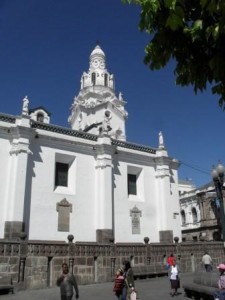
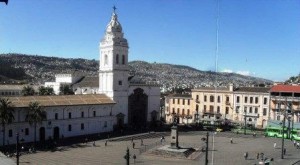 Day 1 is about discovering the small neighborhood streets. The air is dry and the temperature is very moderate (80 celsius), the altitude (high in the Andes mountains) is high and we’ve learned from our travels to Cuzco in Peru that we need to take it slow in order not to get altitude sickness. The Spanish Colonial architecture is grand, well preserved and the spacing around large plazas with mountains as backdrop is very pleasant.
Day 1 is about discovering the small neighborhood streets. The air is dry and the temperature is very moderate (80 celsius), the altitude (high in the Andes mountains) is high and we’ve learned from our travels to Cuzco in Peru that we need to take it slow in order not to get altitude sickness. The Spanish Colonial architecture is grand, well preserved and the spacing around large plazas with mountains as backdrop is very pleasant.
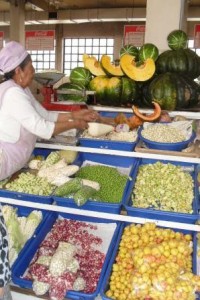 Our favorite destination, in any new city, is the central market.
Our favorite destination, in any new city, is the central market.
It is always a good way to see and sample the local products in a direct way (i.e. not sitting in a restaurant). Well, we aren’t disappointed! Mercado Central of Quito is exceptionally clean, all indoors and small enough to be manageable. We’ve been looking forward to this for some time as we know that the Andes region is particularly rich in its varieties of crop. This is not an accident. The Incas were renowned for their cultivation science and their use of micro-climates to experiment with their crops.
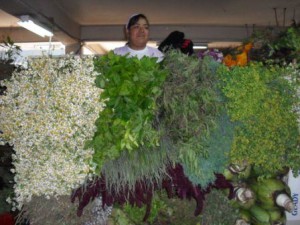 While in North America, people broadly talk in terms of “potatoes” and “corn”, both of these crops are found in numerous varieties that we’ve never seen or tasted before. They differ in size, color, shapes and flavors. Since it’s not possible to taste right there and then all the different potatoes, we decide to do a sampling in the fruit aisle of the market.
While in North America, people broadly talk in terms of “potatoes” and “corn”, both of these crops are found in numerous varieties that we’ve never seen or tasted before. They differ in size, color, shapes and flavors. Since it’s not possible to taste right there and then all the different potatoes, we decide to do a sampling in the fruit aisle of the market.
Here is a sample of Ecuadoran exotic fruit we have never tasted before today:
– Tomate de Arbol (tree tomatoes) : these look like orange tomatoes, but taste a little bit like Guava
-Chilimoya (no translation possible): a white “flesh” around hard large black pits. This was INCREDIBLE. 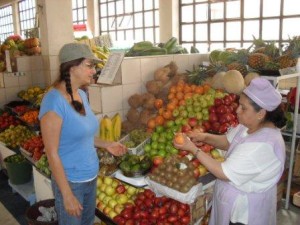 Sweetest fruit we’ve ever tasted.
Sweetest fruit we’ve ever tasted.
– Naranjilla: a cousin of the granadilla
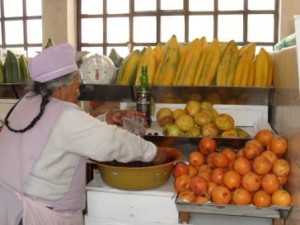
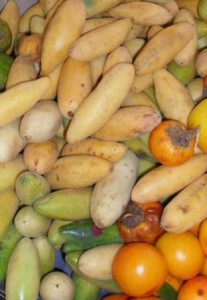
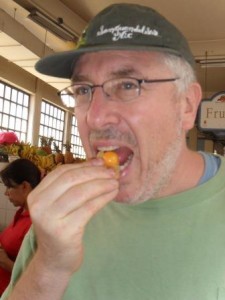 – Guanabana: A large fruit that is mostly used for juices
– Guanabana: A large fruit that is mostly used for juices
– Dalso: a banana shaped guava with crunchy pits
– Villyas: a cute, small bright orange ball that comes protected in its leaf wrapping
The fruit vendor also tells us of all the health / medicinal benefits of each fruit, i.e. this one for kidneys, this one for cancer prevention… Inca medicine was always known to be strong, but only now is Western medicine starting to do serious research in the applications of these ancient crops.
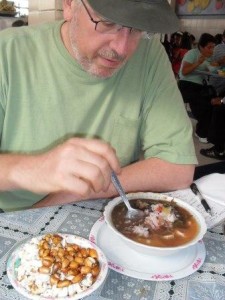
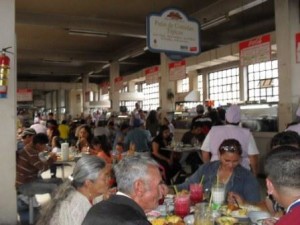 But man cannot live on fruit alone, so we must cross over a couple of aisles to where all the tables are set for the cheapest and best meals in town. Ecuador is known for its seafood and fish, prepared in Ceviche format (raw with lime juice). The Concha (mussel) and Camarones (shrimp) Ceviche looks like soup, is served with popcorn and large hard corn kernels and is outstanding, as is the Mote and Chocro (mixes of four varieties of corn served together, crunchy and delicious).
But man cannot live on fruit alone, so we must cross over a couple of aisles to where all the tables are set for the cheapest and best meals in town. Ecuador is known for its seafood and fish, prepared in Ceviche format (raw with lime juice). The Concha (mussel) and Camarones (shrimp) Ceviche looks like soup, is served with popcorn and large hard corn kernels and is outstanding, as is the Mote and Chocro (mixes of four varieties of corn served together, crunchy and delicious).
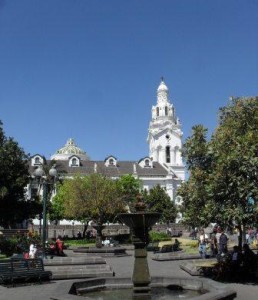
Walking around we can’t help but notice a lot of people in bright yellow soccer shirts. It turns out that today is the match between Ecuador and Columbia that may determine who goes to South Africa for the World Cup 2010. So the city is about to grind to a halt as EVERYONE will go in and watch the game. Hoping for an Ecuadoran win.
